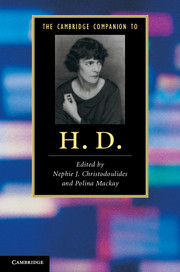Book contents
- Frontmatter
- Introduction
- PART I CONTEXTS AND ISSUES
- 1 ‘Uncanonically seated’: H.D. and literary canons
- 2 Facts and fictions
- 3 H.D. and the ‘little magazines’
- 4 H.D.'s modernism
- 5 H.D. and gender: queering the reading
- 6 Reading H.D.: influence and legacy
- PART II WORKS
- Further reading
- Index
- Cambridge Companions to…
3 - H.D. and the ‘little magazines’
from PART I - CONTEXTS AND ISSUES
Published online by Cambridge University Press: 28 November 2011
- Frontmatter
- Introduction
- PART I CONTEXTS AND ISSUES
- 1 ‘Uncanonically seated’: H.D. and literary canons
- 2 Facts and fictions
- 3 H.D. and the ‘little magazines’
- 4 H.D.'s modernism
- 5 H.D. and gender: queering the reading
- 6 Reading H.D.: influence and legacy
- PART II WORKS
- Further reading
- Index
- Cambridge Companions to…
Summary
Like most modernist poets, H.D. found her first chance to publish her avant-garde work in ‘little magazines’: ‘Priapus’ (later renamed ‘Orchard’), ‘Hermes of the Ways’ and ‘Epigram, After the Greek’ appeared in 1913 in the third issue of Harriet Monroe's new Poetry magazine. Until after the Second World War, some of H.D.'s most important poetry and crucial critical essays continued to appear first in such magazines. During the teens and twenties, her poems could be found in all of the most daring and innovative journals of the time – including (in addition to Poetry), The New Freewoman, The Egoist, Glebe, The Little Review, Contact, Sphere, The Dial, Coterie, Gargoyle, Rhythmus, Double Dealer, Transatlantic Review, This Quarter, The Chapbook, Close Up, transition, Agenda, Pagany, Seed and Life and Letters Today.
This was the era of the great women editors and publishers, including Harriet Monroe of Poetry, Dora Marsden and Harriet Shaw Weaver of The New Freewoman and The Egoist, Margaret Anderson and Jane Heap of The Little Review and Sylvia Beach and Adrienne Monnier of Shakespeare & Company. H.D. knew them all, but like Marianne Moore, who for a few years edited The Dial, she was deeply committed to her own writing career and never wished to make editing and publishing the work of others her dominant literary contribution. Despite this, she was thrust into the role of literary editor on The Egoist during the teens, when she also undertook a stabilising editorial role in the compilation of Some Imagist Poets 1915, 1916 and 1917.
- Type
- Chapter
- Information
- The Cambridge Companion to H. D. , pp. 37 - 50Publisher: Cambridge University PressPrint publication year: 2011

